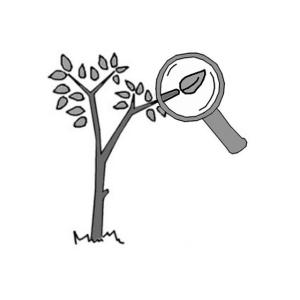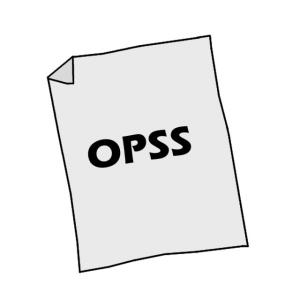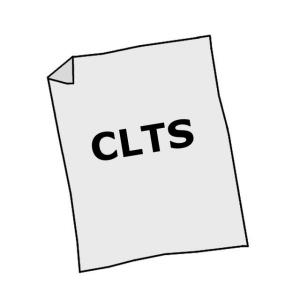Executive Summary
The problem, objective and strategy tree analysis is one participatory tool of mapping out main problems, along with their causes and effects, supporting project planners to identify clear and manageable goals and the strategy of how to achieve them. There are three stages in this analytic process: (1) the identification of the negative aspects of an existing situation with their “causes and effects” in a problem tree, (2) the inversion of the problems into objectives leading into an objective tree, and (3) the decision of the scope of the project in an analysis of strategies. The value of this type of assessment is greatest if it is carried out in a workshop with the stakeholders, giving the opportunity to establish a shared view of the situation.
Introduction
A properly planned project is addressing the real needs of the beneficiaries and is therefore based upon a correct and complete analysis of the existing situation. The existing situation should be interpreted according to the views, needs, interests and activities of parties concerned. It is essential that all those involved participants accept the plans and are committed to implement them. The problem tree analysis belongs to the family of participatory planning techniques, in which all parties involved identify and analyse the needs together, creating ownership and commitment among the involved parties (e.g. beneficiaries, implementing organisations, local governments).
The problem tree, together with the objective tree and analysis of strategies, is a methodology of three steps for identifying main problems, along with their causes and effects, helping project planners to formulate clear and manageable objectives and the strategies of how to achieve them.
Subscribe here to the new Sanitation and Water Entrepreneurship Pact (SWEP) newsletter. SWEP is a network of organizations joining hands to help entrepreneurs design and develop lasting water and sanitation businesses.
Step 1: Problem Analysis
The problem analysis is the phase in which the negative aspects of a given situation are identified, establishing the cause and effect relationship between the observed problems. The problem analysis is of prime importance with regard to project planning, since it strongly influences the design of all possible interventions (MDF 2005). The problem analysis includes (EC 2004):
- Definition of the framework and the subject of analysis.
- Identification of problems faced by target groups and beneficiaries.
- Visualisation of the problems in form of a diagram, called “problem tree” to help analyse and clarify cause-effect relationships.
Like any other tree, the problem tree has three parts: a trunk, roots, and branches. The trunk is the main problem. The roots represent the causes of the core problem while the branches represent its effects. The following figure shows an example of a problem tree related to river pollution.
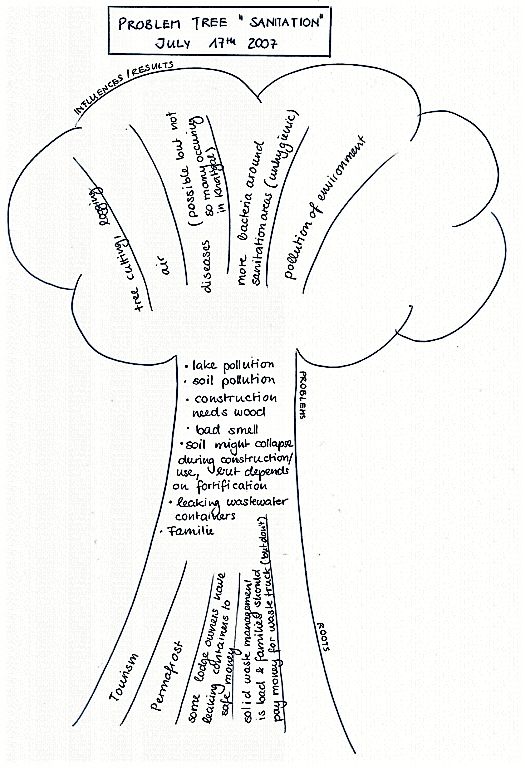
Creating a problem tree should ideally be undertaken as a participatory group event using visual techniques, such as flipcharts or colour cards, in which identified stakeholders can write their individual problem statements. It is recommended that a workshop should involve not more than 25 participants, to provide for a fruitful learning environment. The first step of such workshops should be an open brainstorming about the problems that stakeholders consider to be a priority. From the problems identified, an individual “starter” problem should be selected. In consultation with the participants, a hierarchy of causes and effects has to be established: problems which are directly causing the starter problem are put below and problems which are direct effects of the starter problem are put above. All problems are sorted in the same way (using the guiding question “what causes that?”. Once all the problems are in place, these should be connected with cause-effect arrows, clearly showing key links. After this process, the problem tree should be reviewed and validated by the participants (adapted from EUROPEAN COMMISSION 2004).
Once completed, the problem tree represents a summary picture of the existing negative situation.
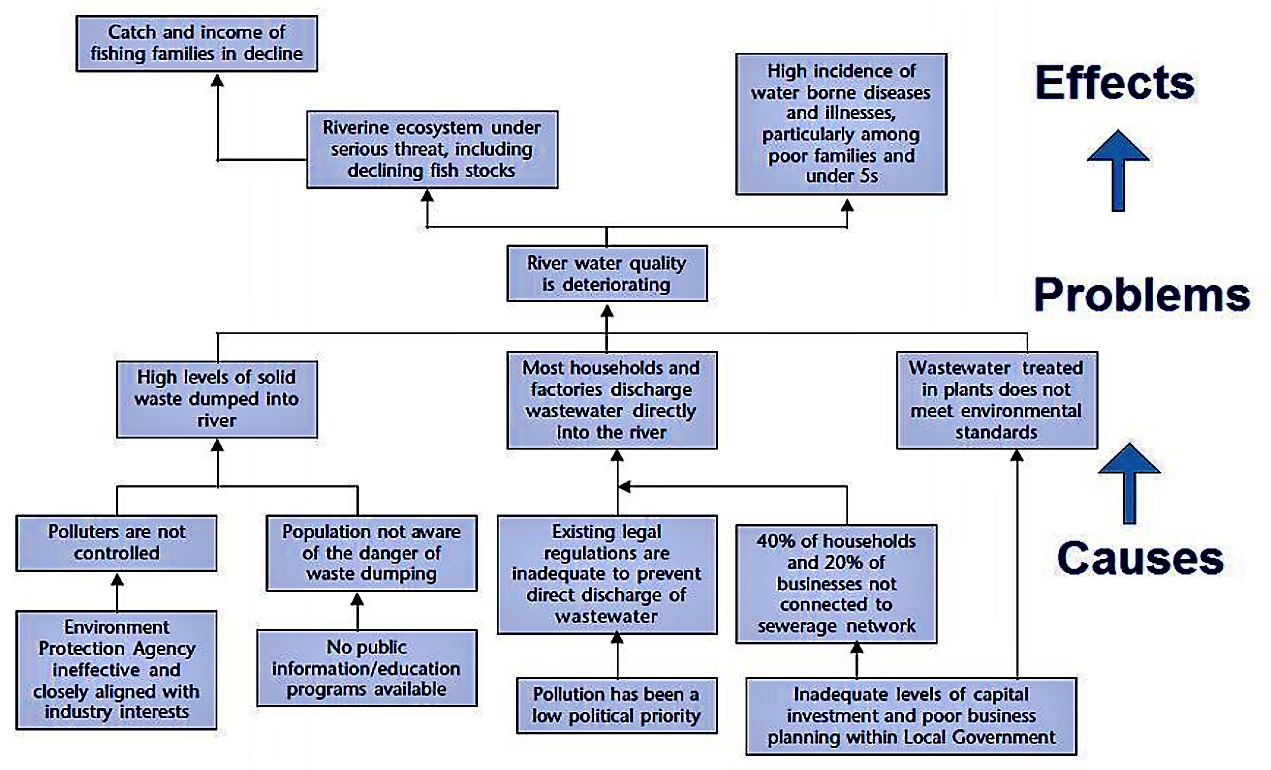
Problem trees do more than just identify the root causes of the problem. They provide a visual breakdown of problems into their symptoms as well as their causes, and furthermore create a visual output that can be understood by anyone. The process can be a useful method in building a community’s awareness (see PPT) of the problem, how they and others contribute to the problem, and how these problems affect their lives. This may also be an important step when attempting to build support for any interventions, new techniques or improved technologies.
Step 2: Objectives Analysis
(Adapted from EUROPEAN COMMISSION 2004 and MDF 2005)
Analysis of objectives is a methodological approach employed to describe the situation in the future once identified problems have been remedied, depicting the ends and the means in a diagram called “objective tree”.
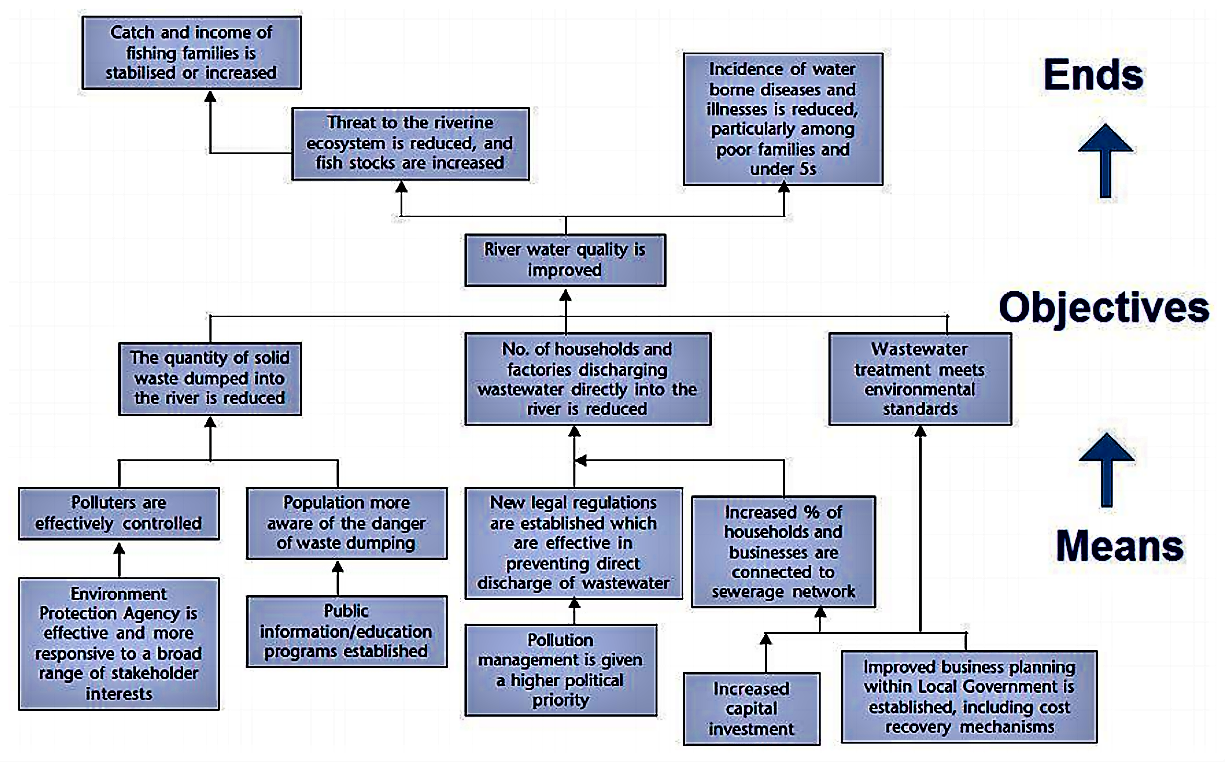
The negative situations of the problem tree are converted into solutions, expressed as “positive achievements”. For instance, in the shown example of river pollution, “river water quality is deteriorating” is converted into “quality of river water is improved”. These positive achievements are in fact objectives, and are presented in an objective tree showing the means/ends hierarchy.
Since the negative situations of the problem tree have to be reformulated into positive situations that are desirable and realistically achievable, it is of primal importance that all stakeholders are involved in the discussions giving their feedback. Appropriate consultation will help to consider priorities, assess how realistic the achievements of some objectives might be and identify additional means that might be required to achieve the desired ends. It might also be necessary to reformulate some of the problems, add new problems or delete problems which might not be relevant or suitable. Furthermore, an objective tree might show many objectives that cannot all be reached at once, for which choices and priorities will have to be made (see also preference ranking).
Once completed, the objective tree provides a summary picture of the desired future situation, including the indicate means by which ends can be achieved.
Step 3: Analysis of Strategy
(Adapted from EUROPEAN COMMISSION 2004)
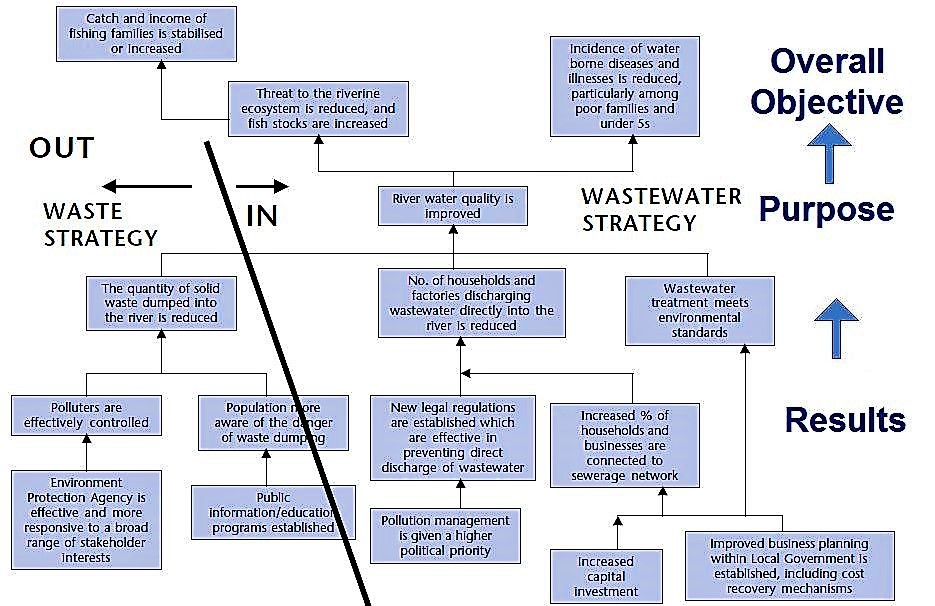
After having decided about the desired future situation, possible interventions have to be selected in order to determine the scope of the project, i.e. what should/can be included within the project.
This analytical stage is the most difficult and challenging, as it involves synthesising a significant amount of information and making a complex judgement about the best implementation strategy to pursue. In practice a balance has to be found to deal with the different stakeholders interests, political demands and practical constraints. However, the potential merits and difficulties associated with addressing problems in different ways have to be fully scrutinised before any detailed design work is undertaken. Typical questions that should be asked and answered are: can/should we tackle all the problems identified? Should we select just a few? Which interventions are more likely to bring about the desired results? What would be more beneficial for the target groups? Are these interventions sustainable in a long-term? Are the financial means available? Do we have the technical capacity to implement the actions? (for more detailed information on this issue, (see definition of boundaries]). These and other questions, including environmental, social and economic issues as well as policies and the legal framework, will help to rule-out those strategies which cannot be covered in this project, and those which are realistic and will offer the most benefit for those facing the problems.
Read our factsheet on project proposal writing to get you started on the path to success!
The problem tree analysis is essential to many forms of project planning in order to improve the sanitation and water system and is often used by development agencies.
A properly planned sanitation and water project is addressing the real needs of the beneficiaries and is therefore based upon a correct and complete analysis of the existing situation.
Applying the problem tree method supports the identification of the main problems along with their causes and effects. This method therefore helps experts and project planners to formulate clear and manageable objectives how to improve and make your sanitation and water system more sustainable.
The process can be a useful method in building a community’s awareness of the problem, how they and others contribute to the problem, and how these problems affect their lives.
The Problem Tree. Analysis of the causes and effects of problems
Ecological Sanitation in the Khuvsgul Area, Northern Mongolia: Socio-Cultural Parameters and Acceptance
Aid Delivery Methods, Project Cycle Management Guidelines
These Guidelines have been prepared to support ongoing improvements in the quality of EC development assistance. Part 2 offers an excellent description of the logical framework approach and how to construct the logframe matrix.
EUROPEAN COMMISSION (2004): Aid Delivery Methods, Project Cycle Management Guidelines . Brussels: European Commission - EuropeAid Cooperation Office URL [Accessed: 07.08.2010]The Problem Tree
This document gives a good overview why and how to conduct a problem tree analysis.
FOODGRAINS BANK (n.y): The Problem Tree. (= Infosheet 103 ). Winnipeg: Canadian Foodgrains Bank URL [Accessed: 10.08.2010]MDF Tool: Problem Tree Analysis
This document explains what a problem analysis tree is, in which situations you can use it and how to conduct this kind of analysis. It also contains concrete case studies of problem trees.
MDF (2005): MDF Tool: Problem Tree Analysis. Ede: MDF Training and Consultancy URL [Accessed: 10.08.2010]
